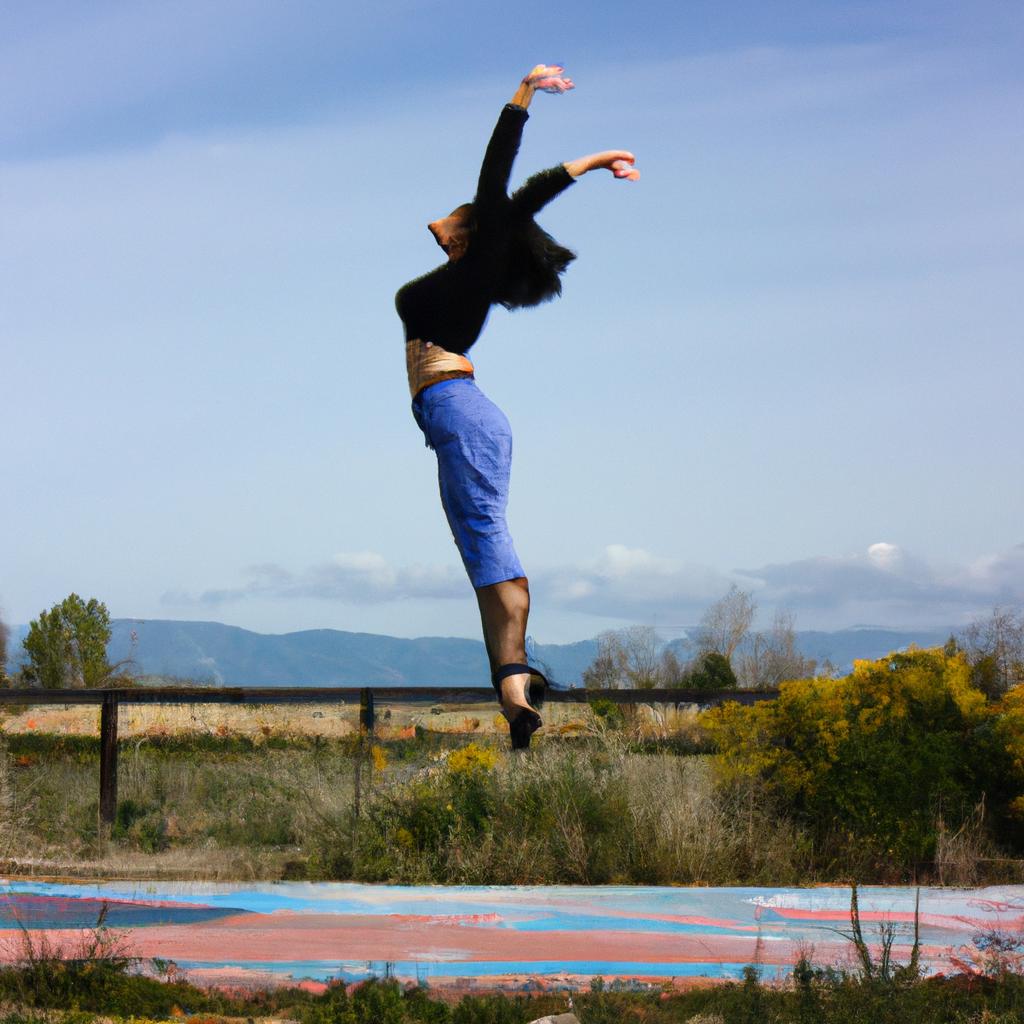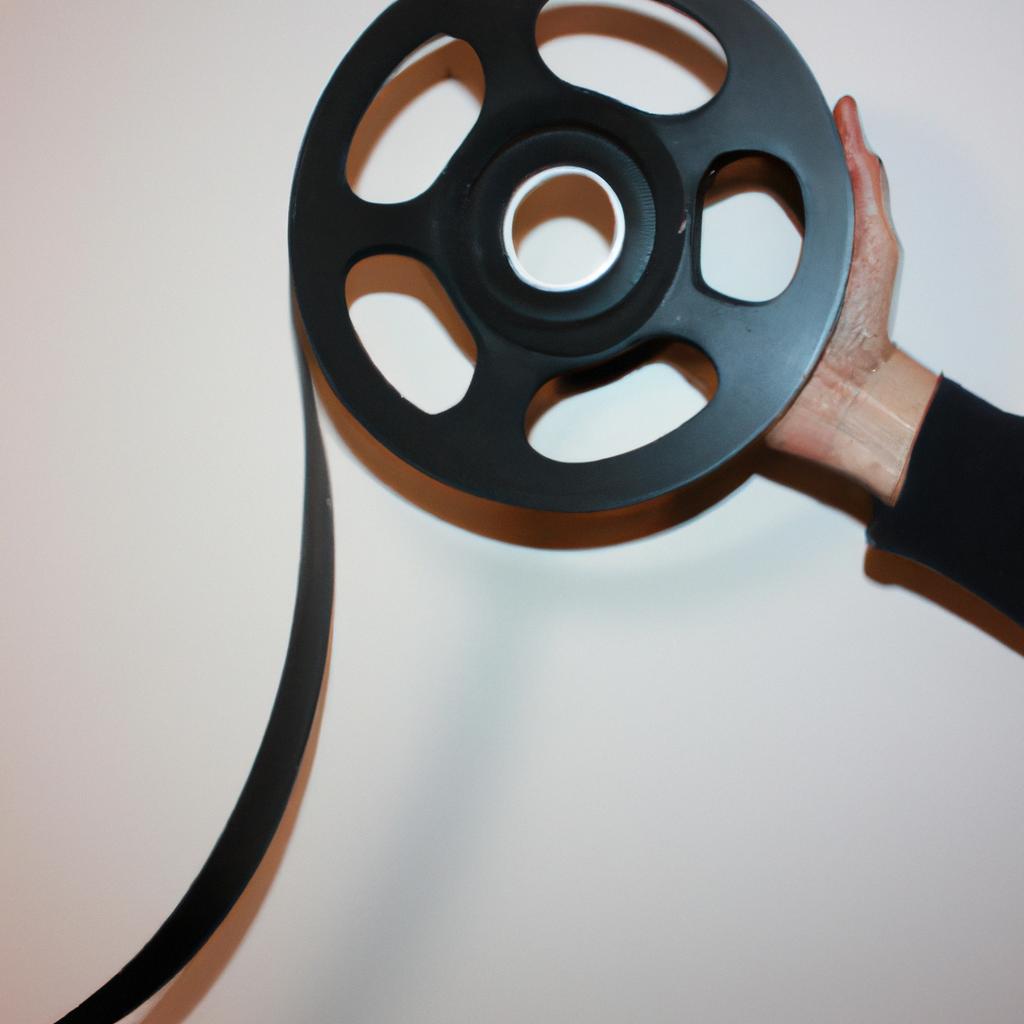Physical Theater: A Guide in the Context of Arts and Entertainment

Physical theater, an art form that combines movement, gesture, and expression to convey emotions and narratives, has captivated audiences for centuries. This unique genre of performance art transcends language barriers, relying on the physicality of actors to communicate with spectators in a visceral and immediate way. For instance, imagine a performer effortlessly gliding across the stage, their expressive body movements evoking a sense of joy or sorrow without uttering a single word. In this article, we will delve into the world of physical theater and explore its significance within the broader context of arts and entertainment.
At its core, physical theater is concerned with exploring the limitless possibilities of non-verbal communication through bodily gestures and expressions. By harnessing the power of movement as a primary means of storytelling, performers are able to tap into universal human experiences that transcend cultural boundaries. Through meticulous control over their bodies’ motion and posture, actors can create compelling characters and narratives that engage viewers on multiple levels – emotionally, intellectually, and aesthetically.
Within the realm of performing arts, physical theater holds a distinctive position as it challenges traditional notions of theatrical conventions such as dialogue-driven scripts or elaborate set designs. Instead, it invites artists to explore alternative modes of expression by tapping into their own physicality.
Historical Background of Physical Theater
Physical theater is a form of artistic expression that combines elements of movement, gesture, and visual storytelling to convey emotions and narratives without the use of spoken language. It has evolved over centuries, drawing inspiration from various cultural traditions and theatrical practices. This section provides a historical background of physical theater, exploring its origins, development, and significant contributions.
One example illustrating the impact and versatility of physical theater is the work of French performer Etienne Decroux. Known as the father of modern mime, Decroux developed an approach called Corporeal Mime in the early 20th century. He emphasized precise body movements and gestures to communicate ideas and emotions with clarity and depth. His influential teachings laid the foundation for many subsequent physical theater practitioners.
Historically, physical theater can be traced back to ancient Greece, where it was an integral part of Greek tragedy and comedy performances. The actors used exaggerated gestures, masks, and bodily expressions to portray characters and tell stories effectively within large amphitheaters. Similarly, traditional forms such as Japanese Kabuki theater incorporated stylized movements and symbolic gestures to convey complex emotions.
Throughout history, physical theater has been influenced by different cultural contexts worldwide. In Europe during the 20th century, artists like Jacques Copeau and Vsevolod Meyerhold explored physicality in performance through their innovative approaches to actor training and stagecraft. Meanwhile, contemporary physical theater companies such as Complicite (UK) or Théâtre du Soleil (France) continue to push boundaries by integrating diverse techniques into their productions.
To evoke an emotional response in audiences when discussing this rich history of physical theater:
- Physicality: Conveys raw human emotion through movement.
- Universality: Transcends language barriers by relying on non-verbal communication.
- Expressiveness: Amplifies feelings beyond words alone.
- Evolution: Constantly adapts to new influences while preserving core principles.
Below is a table outlining key figures and movements in the development of physical theater:
| Period | Key Figures | Influences |
|---|---|---|
| Ancient Greece | Sophocles, Aristophanes | Ritualistic performances |
| Early 20th century | Etienne Decroux | Silent film, body language |
| European Renaissance | Commedia dell’arte | Italian improvisational comedy |
| Contemporary | Complicite, Théâtre du Soleil | Global theatrical practices |
Transitioning seamlessly into the subsequent section about “Key Elements and Techniques in Physical Theater,” it is important to delve deeper into understanding how these historical influences have shaped the art form. By exploring key elements and techniques employed by physical theater practitioners, a comprehensive appreciation for this unique mode of artistic expression can be achieved.
Key Elements and Techniques in Physical Theater
Section H2: Key Elements and Techniques in Physical Theater
Building on the historical background of physical theater, this section will delve into its key elements and techniques that have shaped this unique art form. To illustrate these concepts, let us consider a hypothetical example of a physical theater performance titled “The Puppeteer’s Dream.”
One fundamental aspect of physical theater is the use of body language to convey emotions and tell stories. Performers rely heavily on their bodies as instruments of expression, using gestures, postures, and movements to communicate with the audience. In “The Puppeteer’s Dream,” the performers seamlessly integrate various mime techniques such as pantomime and exaggerated movement to bring life to their puppet characters.
Another crucial element in physical theater is spatial awareness. The manipulation of space can add depth and meaning to performances. In our example, “The Puppeteer’s Dream” utilizes different levels on stage – from low platforms to tall structures – creating visual contrasts that emphasize the power dynamics between characters. This deliberate placement of props and actors within the space allows for impactful storytelling without relying solely on dialogue.
Furthermore, physical theater often incorporates music or soundscapes to enhance the atmosphere and emotional impact of a performance. In “The Puppeteer’s Dream,” live musicians create an original score that complements each scene, providing rhythm and enhancing dramatic tension. From melancholic melodies during introspective moments to energetic beats during action sequences, the carefully crafted soundscape heightens the audience’s engagement throughout the production.
To evoke an emotional response in audiences experiencing physical theater firsthand:
- The juxtaposition between delicate movements and explosive actions creates a sense of anticipation.
- The seamless transition between comedic antics and poignant moments elicits laughter and tears simultaneously.
- The performers’ vulnerability onstage invites empathy from spectators.
- The sheer athleticism demonstrated by artists leaves viewers awestruck.
Table: Examples of Emotional Responses Evoked by Physical Theater
| Emotion | Technique Used | Example Scene |
|---|---|---|
| Excitement | Acrobatics and Stunts | High-flying aerial sequences |
| Wonder | Illusion and Transformation | Magically changing from one character to another |
| Tension | Physical Conflict | Intense fight choreography |
| Joy | Playfulness and Humor | Comic interactions between characters |
In summary, physical theater encompasses a range of key elements and techniques that come together in harmonious synergy. Through body language, spatial awareness, music, and soundscapes, performers captivate audiences emotionally while showcasing their artistic prowess. The next section will explore some famous physical theater performances and companies, highlighting the impact this art form has made on the world stage.
Famous Physical Theater Performances and Companies
Building upon the understanding of physical theater, this section delves deeper into its key elements and techniques that make it a unique form of artistic expression. To illustrate these concepts, let us consider the hypothetical case study of a physical theater performance titled “The Journey Within.”
“The Journey Within” is a powerful exploration of self-discovery through movement and gesture. As performers take to the stage, their bodies become vessels for storytelling, transcending language barriers and relying solely on non-verbal communication. This exemplifies one of the fundamental aspects of physical theater – the use of body language as a primary means of expression.
To further explore the intricacies of physical theater, we can identify several key elements and techniques that contribute to its impact:
-
Body Control: The performers’ ability to manipulate their bodies with precision and control plays an essential role in conveying emotions and narrative arcs. Through rigorous training in disciplines such as dance, acrobatics, or mime, actors develop heightened awareness of their movements.
-
Spatial Awareness: In physical theater, space becomes an integral part of performance. Performers navigate and interact with the surrounding environment while creating dynamic relationships between themselves and objects within it. Thus, spatial awareness becomes crucial in shaping the overall aesthetics and meaning conveyed on stage.
-
Rhythm and Timing: Similar to music composition, physical theater relies on rhythm and timing to create moments of tension, release, surprise or humor. By carefully choreographing movements in sync with specific beats or cues, performers engage audiences emotionally by manipulating tempo and pacing.
-
Object Manipulation: Objects are often utilized creatively in physical theater performances to enhance storytelling or express metaphorical concepts. Whether it be juggling balls representing life’s challenges or using umbrellas as extensions of movement, object manipulation adds layers of symbolism which resonate with viewers.
Through these key elements and techniques mentioned above – body control, spatial awareness, rhythm/timing, and object manipulation – physical theater captivates audiences with its unique blend of visual storytelling. By transcending language barriers and relying solely on non-verbal communication, it evokes a range of emotional responses:
- Awe as performers seemingly defy gravity through acrobatic feats.
- Empathy as bodies contort to express pain or joy.
- Intrigue as objects become tools for metaphorical expression.
- Laughter as comedic timing creates moments of surprise.
To further understand the impact of physical theater in contemporary performance, we will now explore “The Role of Physical Theater in Contemporary Performance,” where we examine how this art form continues to shape and influence modern artistic expressions.
The Role of Physical Theater in Contemporary Performance
Transition from Previous Section:
Building on the exploration of famous physical theater performances and companies, this section delves into the role that physical theater plays in contemporary performance. By examining its impact and relevance within the wider artistic landscape, we can gain a deeper understanding of how physical theater continues to captivate audiences around the world.
The Role of Physical Theater in Contemporary Performance
Physical theater has become an integral part of modern performance art, offering unique avenues for expression and communication. One notable example is “Dreamscape,” a groundbreaking production by a renowned physical theater company. Through seamless integration of movement, gesture, and visual storytelling, “Dreamscape” takes audiences on an emotional journey through dreamscape landscapes. This immersive experience demonstrates the power of physical theater to evoke visceral responses and engage viewers on multiple levels.
Within the context of arts and entertainment, physical theater serves several important roles:
- Breaking down language barriers: Unlike traditional forms of stagecraft heavily reliant on dialogue or text, physical theater transcends language barriers. Its universal nature allows performers to communicate complex emotions and narratives without relying solely on words.
- Exploring non-linear narratives: Physical theater often embraces nonlinear storytelling techniques, allowing for abstract interpretations and unconventional structures. This freedom enables performers to challenge audience expectations while encouraging active engagement with the theatrical experience.
- Offering social commentary: Through its expressive movements and poignant imagery, physical theater provides a platform for exploring social issues and making political statements. It invites reflection upon societal norms, inequalities, and human experiences that resonate with diverse audiences.
- Fostering experimental creativity: With its emphasis on bodily expression and innovative use of space, physical theater encourages experimentation among artists. By pushing boundaries and defying conventions, it fosters individual creativity while contributing to broader artistic innovation.
To further illustrate these roles in contemporary performance, consider the following table showcasing examples from recent productions:
| Production | Description | Key Themes |
|---|---|---|
| “The Silent Revolution” | A powerful ensemble piece exploring the suppression of individuality in a dystopian society. | Conformity, rebellion, identity |
| “Ripples of Memory” | An evocative solo performance that delves into the complexities of memory and its impact on personal narratives. | Time, loss, nostalgia |
| “Unbound Souls” | A visually stunning collaboration between dancers and acrobats depicting the resilience and triumph of the human spirit. | Freedom, resilience, unity |
| “Into the Void” | An abstract exploration of existential questions through intricate physical choreography and minimalist design. | Existence, meaninglessness, self-discovery |
As physical theater continues to evolve within contemporary performance art, it remains an influential force that challenges artistic norms and invites audiences to engage with thought-provoking experiences.
Transition Sentence:
Examining the transformative power of physical theater naturally leads us to explore training and education in this expressive form of artistic storytelling.
Training and Education in Physical Theater
Building upon the understanding of the role physical theater plays in contemporary performance, this section will delve into the various training and education opportunities available for aspiring physical theater practitioners. To illustrate its practical applications, let us consider a hypothetical case study involving a young actor named Alex.
Alex, an ambitious actor with a passion for physical expression, sought out specialized training to refine their skills in physical theater. They enrolled in a comprehensive program that offered a wide range of courses designed to enhance their understanding and execution of movement-based storytelling techniques. Here are some key aspects covered in such programs:
-
Movement Exploration:
- Developing body awareness and control through exercises like improvisation, contact improvisation, and Laban Movement Analysis.
- Exploring different movement qualities such as weight, space, time, and flow to expand expressive possibilities.
- Utilizing elements from diverse movement disciplines including butoh, acrobatics, martial arts, and dance.
-
Partner Work and Ensemble Collaboration:
- Engaging in collaborative exercises to foster trust, communication, and synchronization within an ensemble.
- Learning partner lifts, counterbalances, and other techniques for creating dynamic stage interactions.
- Practicing shared focus and spatial awareness to create cohesive performances.
-
Character Development Through Physicality:
- Studying methods to embody characters physically by analyzing their psychological traits and motivations.
- Experimenting with gesture work, postures, vocalization techniques, and non-verbal communication to convey character depth.
- Incorporating mask work or puppetry where appropriate to explore transformative possibilities.
-
Performance Techniques:
- Understanding staging concepts specific to physical theater productions such as levels, pathways,
proximity/relationship between performers/parts of the set. - Mastering timing precision required for comedic effect or dramatic tension.
- Adapting movements based on audience perspective (frontal view vs 360-degree view).
- Understanding staging concepts specific to physical theater productions such as levels, pathways,
Through comprehensive training and education, Alex developed a strong foundation in physical theater techniques. This enabled them to seamlessly blend movement with storytelling, opening up new avenues of artistic exploration. In the subsequent section, we will explore how the impact of physical theater on audience experience goes beyond mere entertainment, evoking profound emotional responses.
As we transition into exploring the impact of physical theater on audience experience, it becomes evident that this art form has the power to transcend traditional boundaries of performance.
Exploring the Impact of Physical Theater on Audience Experience
Section H2: Exploring the Impact of Physical Theater on Audience Experience
Transitioning from the previous section, where we discussed the importance of training and education in physical theater, let us now delve into the impact that this art form has on audience experience. To illustrate this, consider a hypothetical case study of a contemporary dance performance that incorporates elements of physical theater.
In this particular performance, titled “Through the Veil,” dancers utilize their bodies to convey emotions and tell a story without any spoken words. Through intricate movements, facial expressions, and gestures, they explore themes of love, loss, and self-discovery. As an audience member witnessing this captivating display of physicality and expression, you become fully immersed in the narrative unfolding before your eyes.
The impact of physical theater on audience experience can be profound. It transcends language barriers by communicating through universal human experiences such as joy, sorrow, fear, or hope. The use of non-verbal communication allows for a deeper connection between performers and spectators; it evokes empathy and encourages introspection. Here are some ways in which physical theater influences the emotional response of audiences:
-
Heightened Emotional Engagement:
- By relying solely on movement and body language to convey meaning, physical theater elicits heightened emotional engagement from viewers.
- The absence of dialogue requires audiences to interpret performances based on their own experiences, fostering personal connections with what unfolds onstage.
-
Immersive Storytelling:
- Physical theater creates immersive environments where narratives unfold not only through actions but also through visual compositions.
- Elements like lighting design and stage sets enhance storytelling capabilities while stimulating multiple senses simultaneously.
-
Exploration of Human Condition:
- With its focus on embodied expression, physical theater explores various aspects of the human condition – our desires,
vulnerabilities, strengths, and relationships – resulting in thought-provoking performances that resonate deeply.
- With its focus on embodied expression, physical theater explores various aspects of the human condition – our desires,
-
Creation of Shared Experiences:
- Physical theater provides opportunities for communal experiences, where audiences collectively witness and respond
to the same performance. - This shared experience fosters a sense of connection among audience members and encourages dialogue about the themes explored.
- Physical theater provides opportunities for communal experiences, where audiences collectively witness and respond
To further illustrate these points, consider the following table that highlights key emotional responses elicited by physical theater performances:
| Emotional Response | Description |
|---|---|
| Empathy | Viewers empathize with the emotions portrayed on stage, relating them to their own experiences. |
| Awe | The awe-inspiring physical feats performed by actors leave audiences feeling amazed and captivated. |
| Reflection | Physical theater prompts introspection and reflection as viewers contemplate the underlying messages conveyed. |
| Catharsis | Through intense emotional engagement, physical theater provides cathartic release for both performers and spectators. |
In conclusion, physical theater has a significant impact on audience experience. By employing non-verbal communication techniques, it engages viewers emotionally, immerses them in storytelling, explores various facets of the human condition, and creates shared experiences. Through this unique art form, audiences are able to connect deeply with performances and embark on personal journeys of self-discovery alongside the artists themselves.






